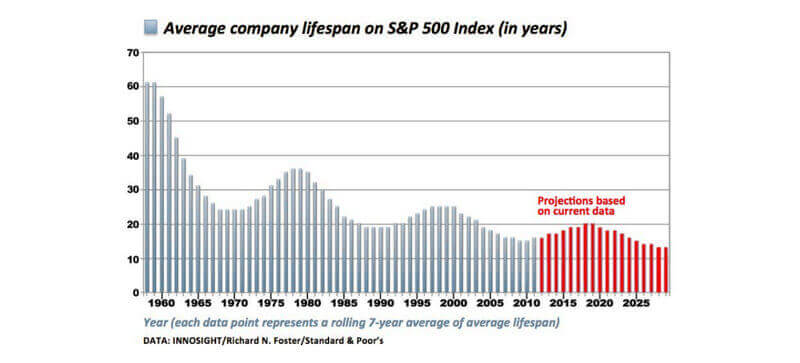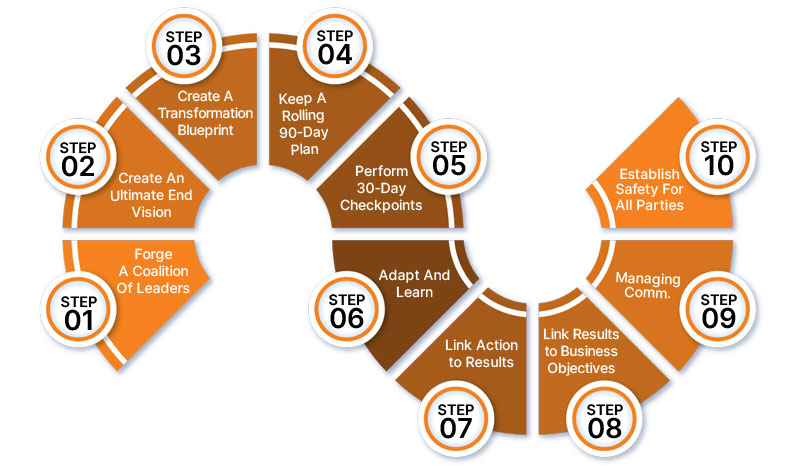Enterprises need to be able to offer product improvements to customers quickly and dependably if they want to prosper and increase their shelf life. They must also be quick to act and capable of handling client feedback. This entails a departure from the overall system for allocating resources, overseeing operations, and organizing labor.

Since gaining alignment may be achieved by gathering everybody in one place and establishing a common vision, Agile Transformation can be simple for small and medium-sized businesses. The time and cost put into implementing the transformation should produce commercial value and truly result in agility in large, complex businesses with legacy technological architecture.
What Is Agile Transformation?
Agile transformation is primarily about creating teams, creating backlogs, and routinely releasing tested, functional software advancements. It involves organizing dependencies, handling trade-offs, launching products quickly, and tracking throughput rather than productivity. The transformation’s task is to get rid of anything standing in the way of achieving these goals.
Strategy For Agile Transformation
When developing an agile transformation strategy, it is crucial to understand the current state of your company, and the direction you want to go. When addressing this problem, two dimensions should have to be taken into account.
You must first take into account the planning priorities of your enterprise. In comparison to the capacity for change, how highly do you value consistent delivery? Even though most businesses value both, there is also a cost.
What your consumers desire from a planning viewpoint is another key thing to take into account. Do you prioritize creating and honoring commitments, (which we refer to as a convergent ecology), or are you attempting to understand what your customers want?

The 10 Steps to Agile Transformation
A company’s value is provided in predictable increments throughout the Transformation by comprehending the appropriate planning process. The objective is to revolutionize the way you conduct business. Since you should be switching beyond “big-bang” product launches to periodic, incremental delivery, all transformation activities must be handled exactly.
Even though each Agile Transformation is unique, we frequently witness the following phases being taken by a company:

STEP 1: Forge A Coalition Of Leaders
Every aspect of the enterprise will need to shift as a result of the agile transformation, and top-level support is required. Ensure that executives are aware of and supportive of the plan.
STEP 2: Create An Ultimate End Vision
Before beginning, you must have some concept of the target, but honestly, expect the strategy to change. It is possible to organize large-scale team development and task organization using well-established patterns. This strategy offers a preliminary concept for the architecture, management, and metrics that will gradually develop throughout the course of the transformation.
STEP 3: Create A Transformation Blueprint
Which cluster, ability, or team takes the lead off? Second? Third? You must provide the enterprise with a general concept of what you’ll do, how long it will take, and the results you want to achieve from the effort.
The teams that transform together are known as Expeditions, and the interim results they reach are known as Basecamps.
STEP 4: Keep A Rolling 90-Day Plan
The transformation top management gathers to make future plans, evaluate performance, and make required adjustments. The objective is to establish a rolling, 90-day plan that is rather clear about what will happen. The 90-day plan ought to resemble a PI or an Agile deployment plan. All the organizational aspects that will be influenced throughout the ensuing 90 days will be listed in the plan.
STEP 5: Perform 30-Day Checkpoints
You want to routinely evaluate the state of the transformation, reflect back, and make adjustments, much like the sprint cycle.
STEP 6: Adapt And Learn
Reevaluate the end-state objective in light of how your procedures have changed throughout the transformation.
STEP 7: Link Action to Results
To produce improved business results is the sole motivation behind what you’re doing. You start out by developing hypotheses, carrying out research, showcasing the results, and making adjustments in light of what you discover.
The objective is to become proficient at ordering the results that must be attained and at assuring that the tasks performed tie back into the intended business objectives, even though not all of the tasks will be known beforehand.
STEP 8: Link Results to Business Objectives
You would like to be able to link system upgrades to concrete business advantages and routinely update the executives on your progress compared to predetermined business metric benchmarks. The end goal is to clearly connect the money spent and the measurable results obtained.
STEP 9: Managing Communication
Motivation and enthusiasm will be generated by the leadership’s consistent, open communication regarding the status of the project and any obstacles. Town hall meetings, executive roundtable discussions, branding, and other data radiators are frequent examples of this.
STEP 10: Establish Safety For All Parties Involved
Assist everyone in understanding their benefits and how they fit within the new company. For everyone, establish clarity, responsibility, and verifiable progress.
How do leaders play a part in an agile transformation?
It takes planning and time to develop a brand-new operation system and migrate from an older one. This requires considerable work, much like product development. It is the responsibility of the executives within the business, beginning with the highest levels (including the Board of Directors), to not just assist in implementing the transformation but rather to actually develop it more. Therefore, it is imperative that leaders are not just present but also actively guiding the ship.
Roadmap For Agile Transformation
A transformation roadmap is essential for effectively transforming a large, complex company. A “learn-as-you-go” strategy will not be successful. According to our research, Successful Transformations tend to adhere to this roadmap.

What is the Time Frame for an Agile Transformation?
42 months are required for each Agile Transformation. Just kidding!
If you’ve made it this far in the article, you already know the right answer: an agile transformation can never be completed since market changes never stop.
“Day 2 is stasis. Followed by irrelevance. Followed by an excruciating, painful decline. Followed by death. And that is why it is always Day 1“
– Jeff Bezos
In order to continue creating value for customers, employees, communities, and stockholders, companies must constantly attempt to improve how they conduct their business and improve their products and services.
Final Words: Sustaining The Changes
Architecture, management, and KPIs will now start to take shape, and you have to start developing your list of best practices. A reliable source for all those practices’ documentation will be crucial for the company’s future growth throughout this period. As a result, you might need to design tactics and procedures for hiring internal experts, carrying out continuing organizational evaluations, and remediation in addition to developing training materials, presentations, and procedure cheatsheets.
Enterprises need Experienced Experts. And we are that.
Summary
Kickstart Your Project With Us!
Popular Posts
CONTACT US
Let's Build Your Agile Team.
Experience Netsmartz for 40 hours - No Cost, No Obligation.
Connect With Us Today!
Please fill out the form or send us an email to







